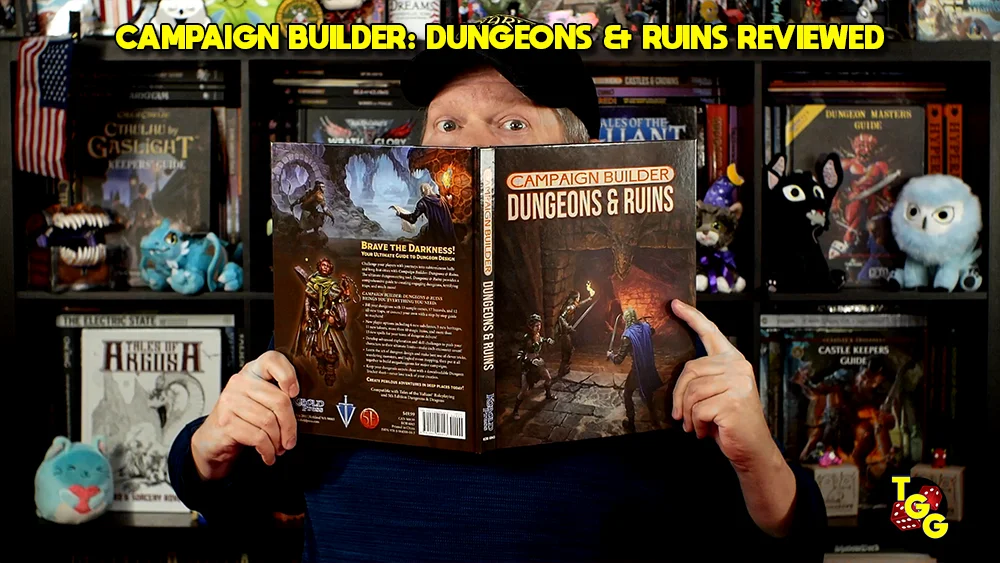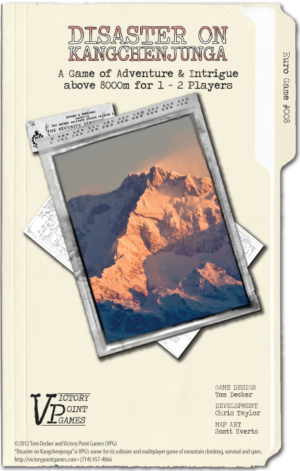
Publisher: Victory Point Games
Designer: Tom Decker
Year: 2012
Players: 1 – 2
Ages: 10+
Playing Time: 60 Minutes
Retail Price: $23.95
Category: Light Strategy
Components:
- One 20-page full color rules booklet
- One 8.5″ x 16.5″ game map
- 28 5/8″ two-sided round markers
- 54 3/4″ two-sided square counters
- One 4-page full color Player aid booklet
- One International Team Status card
From Victory Point Games:
A plane has crashed high up on the slopes of Kangchenjunga, the world’s third highest mountain. One of the passengers was carrying plans that contain secrets that if exposed or delivered into the wrong hands, could threaten world security. Your nation has sent you to join an expedition intent on reaching the summit of Kangchenjunga (Kangch), but you have different orders. You must reach the plane wreck, find the secret plans, and continue the expedition as if you are just one of the team. However, there is a spy among you who will try to sabotage your efforts and steal the plans away from you. There may also be another nation’s team on the mountain with similar interests. It’s a race to the plane crash!
Kangchenjunga is the third highest mountain on Earth, so it makes sense that this would be the subject of the third installment in the “Disaster On…” series from Victory Point Games. The games can be played together in a campaign if you wish, so you can struggle to determine if your climbers can survive scaling the three highest mountains in the world.
Kangchenjunga is located along the India-Nepal border in the Himalayas. The name Kangchenjunga means “The Five Treasures of Snows” as it has five peaks, four of them over 27,720 ft above sea level.
As the name indicates, there is disaster waiting for your team on Kangchenjunga. This time it isn’t the forces of nature that spell doom for your team, but a spy hidden in your own ranks and determined to complete his mission at any cost.
You have your own mission to complete. You are joining an international expedition to reach the summit of the mountain, but only you know your actual goal. A plane has crashed near the summit of the mountain carrying secret plans that if revealed would have disastrous repercussions if they fell into the wrong hands. You need to pretend to be a 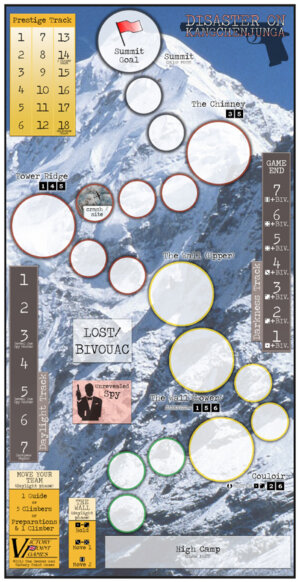
Before we begin I should mention that this is one of the newer upgraded games that VPG is producing now. The rules are in a 20 page full color rule booklet that is a huge step up from all of the VPG rules that I have seen in the past. The counters are now glossy, as is the map, and as a result the colors now have sharpness to them that really pops out at you. I compared them to my old copy of Disaster on Everest, and those seem almost dull and washed out in comparison. I was really impressed in the bump in quality, and I give kudos to VPG for their efforts to improve the quality of their games.
Back on the mountain, at the start of the game you choose either the British or the Chinese team for yourself. If playing the two player game each of you chooses one. You then select one of the two Sherpa that can be assigned to your team, and then choose one of your climbers to represent your agent who is attempting to retrieve the secret plans. This lets you know for sure at least one of the members of your team that isn’t the evil spy.
You mix up all of the other climber tokens face down, and select one to place in the “Unrevealed Spy” box on the board. This is the spy, and hopefully you can learn who it is before they can bring disaster down on your team.
The object of the game is to recover the secret plans, get as many climbers as you can to the summit, and then get them back to camp safely. Your final score will depend upon how well you fare.
Your time is limited, once darkness falls the temperature will drop rapidly and any climbers caught out on the mountain after dark will only have a short time before they freeze to death.
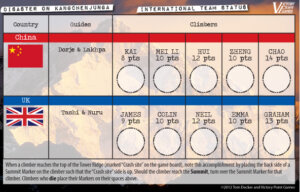
Your climbers ascend to the “High Camp”, the bottom space on the board located at 25,262 feet. There are 18 spots to climb in order to reach the summit, and the plane crash site is located at spot 12.
Getting there will not be easy. There are several ridges you need need to navigate that can become blocked at various points during the game. Additionally, you will have to scale “The Wall”, which has its own movement rules due to the difficulty in climbing it.
The tokens for each climber indicate how many spaces they can move in a turn. The slower climbers can only move one space, and will probably need the help of your Sherpa to get to the top.
The board has two tracks on it to measure the passage of time: the Daylight Track and the Darkness Track. The daylight track has seven spaces that are slowly filled with event tokens, when the seventh space is filled you move to the darkness track. You have exactly eight turns left once darkness settles in to get your climbers back to the high camp, because the game ends immediately after the marker reaches the end of the darkness track.
There is also a prestige track on the board. This represent the amount of points you have to spend on events throughout the game. In a solo game you start with 18 prestige points, and in a two player game you start with 14. Each turn you will pull an event token out of a container. These events can be good or bad, but they only occur if you purchase them with your prestige points. Why would you purchase a bad event? Every event that is not purchased is placed on the daylight track bringing the end of the day, and the game, that much closer.
Once the third space is filled on the daylight track you can flip over one of your other climber tokens to reveal someone else on your team that you know is not the spy. This also occurs on the fifth turn, so by the end of turn five you know a least three members of your team that aren’t the enemy spy.
The event tokens also indicate which of the ridges will be blocked that turn, regardless of whether the event is played or 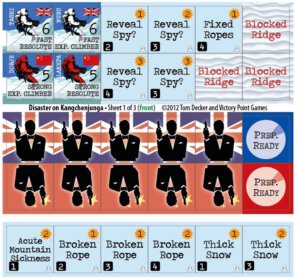
After the event token is resolved your climbers can move. You can choose to move all of your climbers their movement rate (listed on their token), or move your guide to assist climbers, but not both. The slower the climbers are, the more victory points they are worth at the end of the game, so it behooves you to use your Sherpa to assist the slower climbers in making it to the top.
A Sherpa can move multiple climbers, but only one at a time. If the Sherpa has a movement of six, they can move one climber two spaces, move back two spaces, and move another climber two spaces for a total of six. A Sherpa with the strong trait can move two climbers at a time.
At a certain point in the game you will reach “The Wall”. Movement on the wall is different than other sections of the mountain. Once your climbers reach the wall, you will have to roll a die to determine if, and how far, your climbers can move. The wall only covers two spaces, but it might take you a few turns to move those two spaces depending on the roll of the die. At times you can avoid this problem if you happen to have a rope (which is an event you can purchase), or an expert climber Sherpa, or the advanced climber trait.
When a climber finally reaches the plane crash site, you place a crash site marker on that climbers space on the scoring sheet that is included in the game. This will net you four points at the end of the game for each climber who makes it that far. More importantly, you get to have one climber at the crash site pick up the secret plans. You may hand off the secret plans to another climber in the same space at a later time if you wish.
The big question is do you continue on and try to gain the summit for the extra points? Or do you rush the plans back down to the camp? This will have a lot to do with how much time you have left before darkness settles in. If one or more of your climbers manage to reach the summit, you flip over the marker on the score board to the “Summit” side, and you will earn the full victory point value for that climber, but only if they survive the climb down the mountain.
At some point you will be forced to place an event token on the last spot on the daylight track. At this point if the spy has not been revealed yet he is revealed now. Flip the unrevealed spy token over to find out who has been betraying you. Whenever the spy is revealed, you lose control of him. In a solo game there are rules for a spy’s movement. In a two player game your opponent takes control of him.
The spy will relentlessly chase after the climber who has the plans. If no one has the plans yet, the spy will go to the crash site and retrieve them. If the spy catches up with the climber who has the plans they will attempt to take them away. Hopefully you can prevent this. If you managed to get the Walther PPK, it is a big help in keeping the plans out of the spy’s hands. If the spy manages to get the plans, they will try to reach the summit where they will be picked up by their agency. This will cost you victory points if it happens, but you can try to catch them and get the plans back.

At the end of the game you determine the fates of those lost, camped, or stuck somewhere on the mountain and add up your points. In a two player game the player with the most points wins. In the solo game you are competing to beat you highest score, and there is a chart that tells you how great of a victory you have earned.
I liked Disaster on Kangchenjunga. The spy really gives it a fun twist and a few more interesting decisions to make. It reminds me a lot of a James Bond movie. You can hear the narration going on in your head as you play: “The spy catches up with out hero, who manages to escape down the mountain, but becomes lost when she doesn’t reach the bottom in time. The Sherpa uses his last bit of energy to save our hero, but loses his own life in the process. The plans are safely recovered and disaster is averted.”
Disaster on Kangchenjunga is a combination of luck and strategy. I didn’t mind the luck aspect as it brought variety to the game, as does the hidden spy mechanic. Overall, this is a great addition to the “Disaster On…” line.
- A Dungeon Delve for Kids?: A Review of Dungeon! - Oct 24, 2022
- Better, Stronger, Faster | Descent: Journeys in the Dark Second Edition Reviewed - Oct 23, 2022
- Your Planet is Doomed!: Invasion from Outer Space Reviewed - Oct 22, 2022












